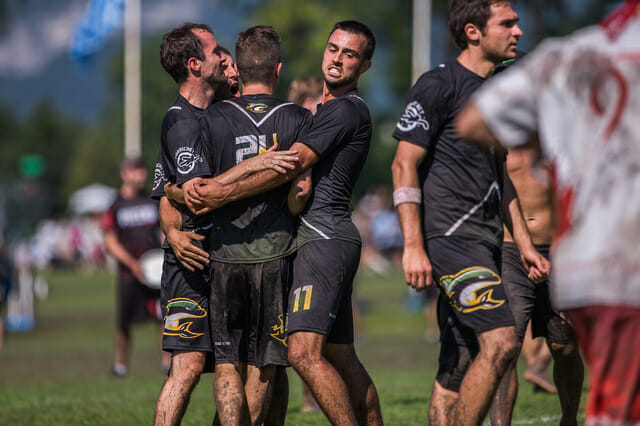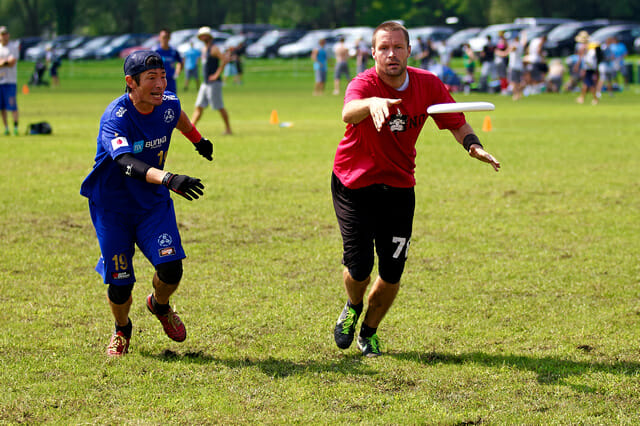Playing Ultimate in France comes with the pervasive problem of securing field space, but it's the unique competitive structure that really makes it different from the American experience. And, if 2014 is any indication, that unique structure lends itself to surprises.
November 18, 2014 by Francis Dieterle in Profile with 10 comments

Field space in large European cities is a rare commodity and though Paris boasts many famous and well-groomed public gardens, the Tuileries and the Jardin de Luxembourg don’t exactly have a space reserved for flatball enthusiasts next to the gift shops. This is why, week in and week out, Ah Ouh PUC (named after a combination of the Paris Université Club sports association and the Mayan god of death) continues to run intervals and hills before hitting the rubber pellets and concrete of Stade Charléty in the very south of Paris for a measly hour of drilling and scrimmaging per week.
Though ultimate may not be the most well-respected or popular sport in the US, the visibility of our sport has taken a huge leap forward in the past few years. French ultimate players are still struggling to find consistent practice fields, especially considering how many soccer and rugby players are competing for the same spaces (and with more money, medals, and cultural acceptance).
The Outside Looking In
Our perception of many international ultimate communities is that the rise and fall of teams is determined by an influx of pre-trained talent from other countries (generally the US). In France, however, the top teams train in-program talent, which allows them to maintain a team core and resist the rebuilding process following the departure of foreign players. Noisy-le-Sec’s (just east of Paris) Iznogood—a perennial contender for the French Men’s title—had only two international players (one from Canada, one from Colombia) out of 23 who participated in the championships this year. Pornichet’s (in the west) Tchac—the 2013 French champions—exemplifies the strength of youth in ultimate, having built a team from scratch up to winning a championship. Even on Ah Ouh PUC, I found out that the players who had left my team after last season were not the normal 1-year ex-pats who instill a team with talent for one year and then leave, but players who had learned with the program and left for other clubs or retired. Though one or two ex-pat players may have an impact on turning a mediocre team into a good team, the top tier of French ultimate still depends on chemistry and depth, one of the main factors for any team with their sights set on a championship.
This summer at WUCC the French showed their chemistry and team-driven ethos by putting up solid results against top international talent: Iznogood gave the Buzz Bullets a tight game, losing 11-15 and Tchac finished 20th, losing to Italy’s CUS Bologna on double-game point.
Objectif Fontenay-le-Comte
The French Open National Championship is played in three phases over the course of two months from March to May. The bottom two teams in Division I drop down, while the top two teams in Division II take their place. The phases are one month apart, giving teams a chance to recuperate and rework their team dynamic, though the timing is somewhat controversial.
“In my opinion, the season is poorly timed,” says François Zoubir, captain and coach of Iznogood. “We start our first phase in March and finish at the end of May. Because of this, we can’t participate in pre-season tournaments with other European teams, since there are very few outdoor tournaments in January and February.”
Maintaining consistency without much chemistry over three weekends is a unique challenge. Teams have to hit the ground running on the first weekend and set the tone for the rest of the championship. This is true both for teams at the top and at the bottom, as losing the wrong game can put your dreams of a championship on hold or send you back to Division II to rebuild. This year, going into the first phase, all eyes were on Tchac to come out in force and dominate, with Créteil’s (south of Paris) Sun and Iznogood fighting for second.
Once again, the issue of field space factors into the way that Nationals is structured in France. Each team had only four games during the weekend, which meant a lot of sitting around watching other teams and getting cold before the second game.
It was a frustrating weekend for my team, Ah Ouh PUC — showing how hard it is to build chemistry with just one hour of practice time a week — and we dropped to a disappointing 0-4, one game after another. During our breaks we watched an athletic Tchac take down every competitor with relative ease in the first phase and cement their spot in the power pool, capping the weekend off with a 17-8 blowout against rising powerhouse Iznogood.
It’s important to perform well on the first weekend of the championship, but the second weekend is where the top competition begins to separate itself out from the rest. “That huge loss gave us a chance to rally the team and analyze what we had to do to beat them, since we knew the finals would be through them,” Zoubir said of Iznogood’s performance in the first phase.
This time off had clearly had an effect on the level of play. In the second phase, Tchac seemed to have lost a little ground. After several offensive miscues and lackadaisical defense, Tchac found themselves down 10-13 to Sun on the first day. After a clean offensive possession, though, Tchac ground out three breaks in a row to close the game out: 14-13 Tchac.

One month later, all eyes were on Tchac. After narrowly losing to Swiss powerhouse Freespeed at Tom’s Tourney, everyone fully expected a dominant performance and a decisive repeat championship in phase three at Fontenay-le-Comte. While the bottom teams fought it out to see who would have to fight their way back into Division 1 and my team, Ah Ouh PUC, lost the decisive “game to stay,” but the finals were set: Iznogood-Tchac.
The match began back and forth, with both teams trading on offense. Tchac showed off their technical throws and their ability to break the mark, while Iznogood relied on their hucking game to their big receivers. However, slowly the Iznogood defense began to lock down on Tchac’s handlers, generating one block after another.
The defending champions went into half down 5-9 and continued to collapse down the stretch, hemorrhaging one break after another to the rabid Iznogood defense. In the audience, we were stunned. Where was the team that had nearly taken down Freespeed? Tchac was falling apart and an easy repeat at this point just seemed like hubris. Soon enough it was over: 17-10 Iznogood for their first title since 2007.
“The determining factor in that game was without a doubt hard work and team solidarity,” said Zoubir. “Tchac were more technically skilled than us. They have solid fundamentals and players who are capable of throwing consistently in any conditions.”
Paris may not be Seattle or San Francisco, but Zoubir makes it clear that the quality of French ultimate is on the rise: “If you are in Paris and you would like to play ultimate at a high level, welcome to Iznogood.”